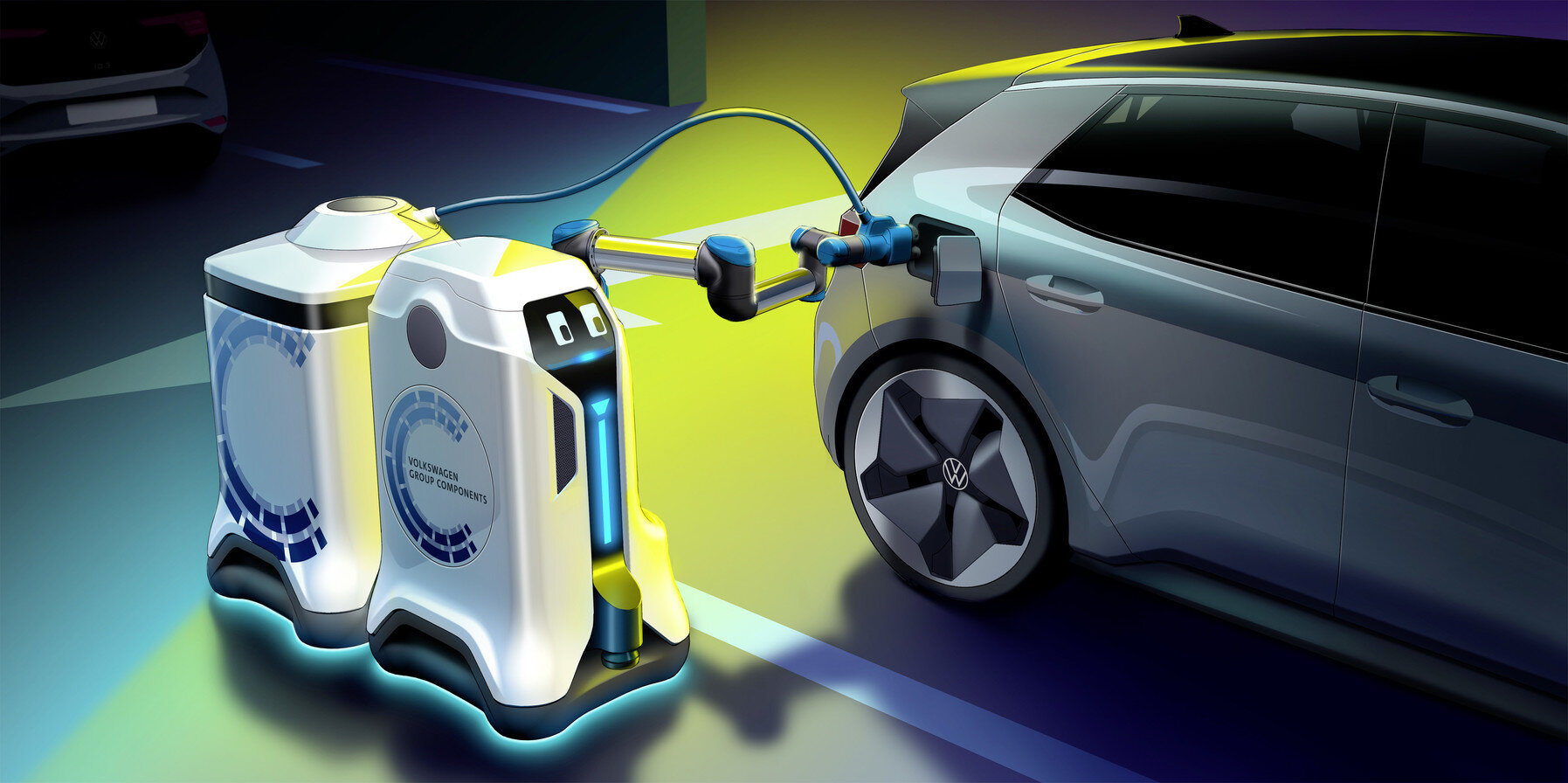VOLKSWAGEN

See that blue car in D8? A robot is charging it
OK, this is the future and it is just a normal day at a parking garage where the new norm is the electric vehicle. A little blue car pulls in and ambles over to the lane space of D8.
The owner, before departing and taking the lift up to the 28th floor, calls up an app on his smartphone and the screen says "request for capacity?" (Summoning the robot happens either via a mobile app or vehicle-to-everything (V2X) communications.)
A row of storage devices plus a robot are lined up against a wall. The robot lights up with two eager eyes. Charge alert. The robot is ready to roll and takes a battery wagon along with it to the blue car in need.
The robot, said Darren Quick in New Atlas, connects the battery wagon, which includes built-in charging electronics, to the vehicle to start charging. The battery wagons support DC quick charging up to 50 kW, and have a capacity of around 25 kWh. (The press release said, "With its integrated charging electronics, the energy storage device allows for DC quick charging with up to 50 kW on the vehicle.")
Once the charging service is complete, the robot collects the energy storage device and brings it back to the charging station. When the car owner will return to his car he will call up the smartphone app, which says the car is charged.
On Thursday Volkswagen posted a video of the charging robot.
The mobile charging robot prototype is from Volkswagen Group Components. They make a point of how Volkswagen is bringing the charging infrastructure to the car—and not the other way around.
The robot (1) opens the charging socket flap (2) connects the plug (3) and on to decoupling, all without human interaction. These robots are fitted with cameras, laser scanners and ultrasonic sensors— autonomously driving to the car in need and able to maneuver around the parking lot successfully, able to recognize possible obstacles and to react.
The robot is only part of the prototype solution—then there are the "battery wagons," which are energy storage devices.
The robots move these battery wagons – 25-kilowatt-hour battery packs – to a vehicle where the robot then connects the battery wagon to the vehicle, said Motor1.com. "The robot is capable of operating several battery wagons at once, said the article, "taking them to vehicles, connecting them, and returning them to their home station once complete to recharge."
The VW news release similarly explained that "these are equipped with an energy content of around 25 kWh each. A charging robot can move several battery wagons at the same time."
Darren Quick in New Atlas: Splitting the robot butler from the energy storage device "allows the robot to attend to other cars without having to wait until a vehicle has finished charging."
Volkswagen is looking at the potential appeal of all this in less money spent for "charging infrastructure."
(Earlier this year, in June, a Volkswagen executive stated that "Charging an electric car must become just as easy and normal as charging a smart phone. This is why we need significantly more charging stations in public spaces.")
What's next? At the time of this writing, Volkswagen had no date for a market launch of the charging robot. According to the company news, however, there is a serious effort to make charging points more easily available. By 2025, for example, expect to see the company "installing a total of 36,000 charging points throughout Europe."
As of January 1, 2019, the Volkswagen Group had a new brand: Volkswagen Group Components. It is regarded as an independent unit but under the VW umbrella.
by Nancy Cohen

Nenhum comentário:
Postar um comentário